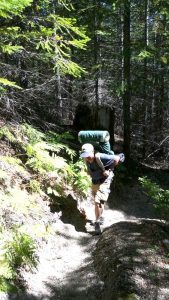 You would have liked it. It was steep. It was steeper than Ruckle Ridge, steeper than Herman Creek, steeper than Wind Mountain. Steeper than any trail you’ve likely been on. It wasn’t a casual “I need to take a break now” sort of steep, it was seriously steep. I mean, we didn’t have to rope up, but it required calling upon reserves of willpower I am unaccustomed to depending on, just to put one foot in front of the other.
You would have liked it. It was steep. It was steeper than Ruckle Ridge, steeper than Herman Creek, steeper than Wind Mountain. Steeper than any trail you’ve likely been on. It wasn’t a casual “I need to take a break now” sort of steep, it was seriously steep. I mean, we didn’t have to rope up, but it required calling upon reserves of willpower I am unaccustomed to depending on, just to put one foot in front of the other.
I had wanted to go to Deadman’s Lake since I’d read an account given about the death of James Hartley in the September 9, 1896 edition of the Oregonian (the internet is a wonderful thing):
…James Hartley, a collector of Indian relics and curios, was found last Thursday by Henry Peterson, a timber cruiser, on a small island in Deadman’s Lake in the dense forest which stretches from Mount Saint Helens to the Columbia River. The body, which was found in an old canoe, the hands and feet bound by writhes of hazel and fastened to the stem and stern of the canoe, with a stake of hazel driven through him just below the breast bone, was in a comparatively good state of preservation, and was readily recognized by the clothes of peculiar greenish colored corduroy, which he invariably wore, and by letters and papers found in his pockets…
Pulling out my Gifford Pinchot National Forest map, I found the lake just where the old newspaper said it would be, a little north of Mt. St Helens. The trail in was only five miles, but I could see from the map it gained over fifteen hundred feet in the two miles. Quite a climb for a fat old man. I began to plan a camping trip.
My brother-in-law, Dave McFarlane, said he’d go with me. Neither of us had done any backpacking since our twenties. I was nearly sixty and Dave is a couple of years older than me. Between we scrounged up the necessary equipment, most of which was better suited for a museum exhibit than an expedition. Our packs weighed a little over thirty pounds apiece, before we added the water.
Dave and I parked at the trailhead a little later than I had hoped and it was getting on past noon by the time we started walking. I had expected the remoteness and difficulty of the trail to ensure solitude, but there were a half a dozen cars already there.
The trail climbs from the first step and continues up through old growth white pine and Doug fir, one switchback following another in seemingly endless succession. I was anxious to make time, and started out at a brisk pace. Behind me, I heard Dave say “Take it easy, don’t burn yourself out.” I slowed down. It wasn’t long before I slowed even more. Soon I was having that internal dialogue, urging myself on. “We have only been walking for ten minutes. You can take a break soon. Let’s just walk for half an hour. You can do it!” I made it twenty minutes.
We went on like that, twenty minutes at a time, with five minute breaks to catch our breath and sip some water. Always up, climbing up, up. “We’ve been walking for forty minutes, Dave.”
The trees were tall and straight. Looking down I saw only more trees until the shadows blurred the distant trunks into a wall of dimness. There was almost no understory; a fire must have come through here sometime, years ago. I looked up the hill and saw nothing but trees, the slope curving out of sight, promising more of the same above.
“Look. Another switchback!” Unaccustomed to wearing a pack, my shoulders chafed; my sweat soaked t-shirt felt like sandpaper on my skin. Dave was ahead of me. He paused so I could catch up. “You want’a stop for lunch?
Let’s get out of the trees first. It can’t be much farther.”
Dave nodded and started back up the trail.
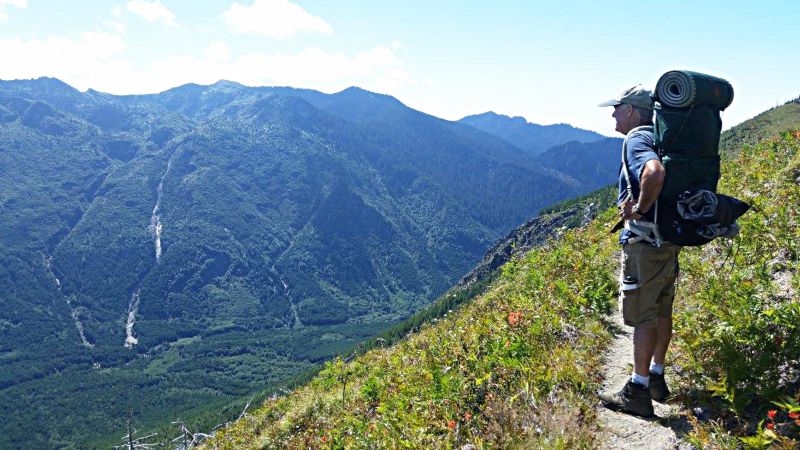
We began to see blue sky through the trees ahead of us. It seemed we were nearing the summit. Rounding yet another switchback we found this to be a cruel hoax; the horizon disappeared behind a steep shoulder. The trail continued up. Then, through a break in the trees, a vista opened before us. We looked across Green River Canyon to Whittier Ridge and the shattered maw of the crater of Mt. St. Helens. Far below us we could see the bend in the road where we had parked the truck, and Ryan Lake, a small pond choked with the remains of trees toppled in the 1980 eruption.
I dropped my backpack and sat down on a stump. We dug our sandwiches out of our knapsacks and devoured them. I tipped back my head and guzzled warm water from a plastic flask. We sat there long enough for the flies to discover us; too tired to swat them away, we pushed ourselves to our feet and shouldered our packs. One of the ancient canvas straps on Dave’s pack had rotted and suddenly gave way. I handed him some twine and gratefully rested against a tree for a few more minutes while he made repairs.
There were no more switchbacks but the trail continued to ascend. The trees were smaller now, with dense groundcover underneath. Ferns and a profusion of wildflowers lined the path. Strawberries and thimbleberries were beginning to fruit; we marched through huckleberry bushes above shoulder height, grazing as we walked. It looked as if the bears had been doing the same thing; we stepped over lumps of dark purple scat about every fifty yards.
As we neared the ridgetop, the trees gave way to open meadows dotted with bright red Indian paintbrush, lavender and yellow asters and the graceful white florets of yarrow in bloom. We could see Mt. Rainier far off to the northeast, with miles of tree covered mountains and valleys between us. Behind us we could see Mt. Adams and to the south, Mt. Hood’s glacier covered peak glistening white against the summer sky.
We found ourselves on the knife edge of a ridge which dropped steeply on the south and north sides. The trail continued west. It had taken us two hours to get here and we still had at least three miles to go. A slight breeze blew unimpeded along the rocky spine. It felt good to be out of the trees. We were no longer climbing but the narrow trail traversed a dangerously steep slope and demanded careful attention. My legs knotted with cramps. We kept walking.
The two sides of the ridge were in stark contrast to each other. The north slope was covered with dense forest and dotted with ponds and lakes. The south slope was barren sand and tan colored pumice with some sparse, weedy groundcover. We walked beyond the last few living trees. They were stunted and bent by exposure. After that, only twisted snags, shorn of every vestige of life, stood; mute testimony to the devastation from Mt. Helens’ eruption, thirty-six years ago.
“Gosh,” Dave remarked. “Can you imagine what it would be like up here if the mountain went off? There’d be nowhere you could go!”
I glanced around us. The trail descended into a blasted landscape and paralleled the ridge, several hundred yards below the top. Rock outcroppings jutted from the steep pumice incline. Here and there stood dead trees, bare wood cracked and weathered silver. Below us, cliffs dropped abruptly into a deep canyon which rose on the other side to another range of mountains, just as steep and high as where we stood. On the shadowed north slope new growth struggled to renew the forest, pushing up through dead trees scattered like toothpicks by the volcanic explosion more than three decades ago. Behind that ridge loomed Mt. St. Helens, its blackened caldera tipped lik a cannon pointed in our direction. I felt vulnerable and exposed.
“Let’s keep moving.”
We walked on. The trail began to climb again. Ahead of us a rock cliff rose another thousand feet, to the peak of Goat Mountain.
“We don’t have to climb over that?” Dave gasped.
“No”, I replied. “I think the trail drops over the ridge below it on the other side.”
And so it did. We followed the sandy path around a large rock, over the crest, and down the north slope where it continued a gentle traverse through a jungle of dense, green brush. This side of the ridge was entirely different: cooler, moist, with flowers and mushrooms everywhere.
An Amanita the size of a dinner plate thrust up through the tangle, the bright red mushroom speckled with white, brilliant against the green moss, ferns and vines. I saw a frog hop across the trail. We almost paused to rest but the mosquitoes found us immediately, so we thought the better of it. Ahead of us the trail vanished into old growth forest, predominantly Douglas fir and incense cedar. The bugs disappeared as we entered the trees and wildflowers gave way to broad, open spaces carpeted with a dense, spongy mat of decaying needles, laced with emerald green swaths of wild vanilla.
There were more switchbacks. I trudged on, mechanically moving my feet forward, one step at a time. As we descended into the valley, hemlock replaced cedar and silver fir replaced the Doug
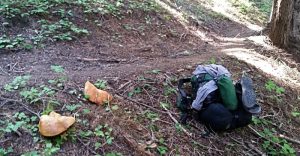 “Dave! Check this out.”
“Dave! Check this out.”
“What are they? Are they edible?”
“Boletes, probably kings,” I replied. “They are one of the best edible mushrooms in the world! The French call them ceps and the Italians, porcini.”
Dropping my pack, I tipped the closest one over. There was a ripping sound as it tore free of the duff. The stipe was solid and shaped like a club. The mushroom weighed as much as a small chicken, but I was disappointed to discover the pores under the cap had turned a slimy olive-yellow. It was too old to eat. The others were also past their prime and riddled with bugs.
We still couldn’t see the bottom, but the hill became bowl-shaped and it felt like we must be getting close to our destination. There were more and more boletes and the forest had a magical quality to it. I don’t know if it was the excitement of finding the mushrooms or if the trail had just gotten that much easier, but I felt renewed energy. Sunlight slanted through the firs, lending a warm glow and slicing the shadows into ribbons. The trail finally flattened out, winding around small hillocks and mounds.
It was dry now, but obviously, the low parts had flooded in the winter. Mushrooms were everywhere. I had never seen so many huge boletes in one place. I managed to collect a few that were white and firm; one about twelve inches across and several more that were softball sized. I almost drooled anticipating dinner.
The trail here was built up and reinforced with some kind of mat to prevent flood damage. When we came to an unmarked fork we went left. For a short way, huckleberry bushes and wildflowers lined the trail, then we were again in old firs on a hill that dropped down to a sandy beach. Before us, Deadman’s Lake sparkled in the late afternoon sun.
We were the last people to stumble into camp. There were a dozen tents set up around the edge of the lake, with all the good sites on this side already occupied. We hiked south, around a brush choked meadow to a secluded stretch of beach surrounded by tall timber. We shed our packs and walked down to the shore. Finally rid of my burden, I felt almost lighter than air, like an astronaut on the moon, able to leap effortlessly and take giant strides. I couldn’t of course; I was exhausted.

Dave and I sat on a piece of driftwood and stared across the lake. It was larger than I’d expected, almost half a mile across. The water was as smooth as glass with a narrow strip of sand surrounding it, bordered by dense conifer forest. The sun felt warm on my face.
I opened a flask of rye whiskey, taking a pull before I handed it to Dave. Fishing a copy of the old Oregonian newspaper article from my pocket, I began to read aloud.
…Some such dreadful ending had often been predicted for Hartley, as he had been for years engaged in collecting Indian relics and curios, and has probably robbed more Indian graves and scattered broadcast the remains of more Indians than any other one man ever did. There is scarcely an Indian burying ground on the Columbia River, or the islands therein, or along the coast of Oregon, where Hartley had not ransacked in search of stone knives and hammers, beads, flint arrowheads, and other articles which Indians used to bury with their dead: and in several places, notably at Long Island in the Upper Columbia River, dead houses of modern construction were torn down by him, and the only partially decayed bodies of those buried therein dragged out and thrown about to bleach in the sun and wind in his search for any articles which might have been buried with them…
“Here,” Dave said, passing the flask back to me. I took another pull before continuing.
…Since the Indians have been removed to reservations, in most cases far from the burying grounds of their ancestors, such men as Hartley have plied their horrible business without much fear of being disturbed. Hartley had been so long and so actively engaged in the business, and his operations had extended over such a scope of territory, that he was known by reputation at least to many Indians, and whenever it was known that he was in any part of the country – Indians from that section sent out guards to protect their old burying places.
Some two years since, while he was operating in an extensive Indian burying ground at the mouth of the Alsea River, he was shot at and narrowly escaped being captured by Indian guards sent down from the Siletz reservation to keep watch for him, the Indians having learned that he was on the way to that place. Another time, when collecting Indian skulls at a burial place on Little Memaloose Island, in the rapids at the foot of The Dalles, he narrowly escaped being captured as the canoe of his pursuers having been upset by their over eagerness to catch him.
“What was he thinking? I mean, how would he like it if someone dug up his grandmother’s grave and stole her skull for a souvenir?” Dave reached for the whiskey.
…Owing to dread of Indians, Hartley had for some time kept his movements as secret as possible, and so his disappearance attracted no attention until some six months since, when his brother came out from the East to inquire about him. The last his brother has heard from him he was collecting Indian curios along the banks of the Cowlitz River, where there used to be many Indian villages in the early days, and where thousands of Indians from the interior gathered during the spring and summer to put up smoked salmon for winter use. He had written to his brother that he intended to go to some islands in Silver Lake, over toward Mount St. Helens, to examine an old Indian burying ground there, and that was the last that was known of Hartley’s whereabouts. His brother visited the islands in Silver Lake, and found traces of him in scattered remains of Indians and canoes, and here all traces of Hartley failed.
It seems probable that Hartley had learned of the burying ground on the island in Deadman’s Lake, some 20 miles further in the forest, where tradition says chiefs and medicine men of several tribes along the Columbia River use to be buried, and lured by the prospect of a rich find of curios, he had ventured to visit the place, imagining that he would be safe from molestation in the depths of that great forest. The Indian guards evidently caught him and put him to cruel death, and his fate might never have been known had not the timber cruiser, Peterson, been led by curiosity to visit the island.
“That guy was an asshole! It’s no wonder they killed him.”
“Yeah,” I replied, taking another drink. “It must have happened right around here.” I idly tossed a hazelnut into the lake. Looking behind me I saw a clump of hazels growing from the bank. I felt a passing chill.
I wanted to camp on the beach but Dave didn’t think we should. We settled on a flat spot back in the trees, a little more sheltered but still just a stone’s throw from the water. There was a burned spot and a pile of blackened rocks from a previous campfire. Dave brought a large flat rock up from the beach which we used for a hearth, placing the soot covered stones in a ring around it. We soon had a fire blazing merrily and began to set up our tents.
When I was gathering my camping gear in preparation for this outing I discovered my smallest tent weighed over five pounds. I left it behind and brought a Mylar tube tent instead. I suspended the foil sleeve on a line strung between two trees and tied the bottom edges out to a couple of rocks. I tossed my gear inside, planning to deal with it later.
Dave wasn’t even sure what kind of tent he had brought. He’d just grabbed something from a pile of camping equipment in his basement, left over from years of family outings.
“That looks pretty big, Dave. I thought you were bringing a bivi-tent?”
“I think it is my daughter’s tent,” he said, unrolling what looked like a five-person dome tent. Once he figured out how the poles fit, it went together easily.
With shelter attended to, it was time to turn our attention toward food. I fed twigs into the folding pocket stove I’d packed in, and set an aluminum pot on top. Before long I had diced boletes boiling in water. Chopped carrots, and a hardboiled egg over ramen noodles completed the meal. I wished I had brought some olive oil or butter so I could properly grill some of the mushrooms, but dinner was quite satisfying, even so. The boletes had a rich, nutty taste and absorbed the salt and flavor from the broth. They were a firm and meaty presence in the dish. Dave thought they tasted like dirt. Philistine. For dessert we had hot chocolate spiked with applejack.
Dave went down to the lake to look at the stars while I tried to get my sleeping bag spread out inside the foil palace. I caught the opening of the tube with my shoulder as I was crawling inside. The Mylar ripped apart, leaving a tattered silver banner flapping in the breeze. About that time, Dave wandered back from the lake.
“Clouds are moving in,” he said. “I couldn’t see hardly any stars.”
“I destroyed my tent being clumsy.”
“You can share mine. There’s plenty of room.”
Dave is a generous guy. I moved my bedroll into his tent and was asleep within moments. This is where I should tell you a ghost story. Something about the shades of Cowlitz warriors moving in the darkness, perhaps shrieks in the night, echoes of a grave robber getting his comeuppance, bound to a tree with cordage made from the bark of the same hazelwood the stake which he was impaled on had been carved from. I’d like to tell you a ghost story but I can’t. I slept soundly and undisturbed the whole night through. Dave was up during the night, but he claims that was due not to ghosts, but an uncomfortable root protruding into the middle of his bed.
It was cold and overcast when we got up the next morning. Low, grey clouds hung over the lake, threatening rain. Dave had some coffee and I drank tea while we packed up, skipping breakfast in favor of leaving before the weather deteriorated. Before we broke camp Dave secured for himself a sturdy walking stick from the piles of drift on the lake shore.
We followed a group of college kids out, but they soon left us far behind. The trail out was steep but not nearly as long as the climb on the other side. Even though it was damp and overcast we worked up a sweat, shedding our jackets before we were halfway to the ridge.
The cliffs above us were hidden in clouds and when we crested the ridge, the brume enveloped us and hid the canyon from our view. It was as if the hill fell away into an empty, white abyss and we climbed towards an indefinite objective, moving always just out of reach. Our world was monochromatic, nothing but shades of grey and white, the skeletons of a dead forest reaching up for us through the fog, monolithic black rocks looming and disappearing, indistinct yet ominous, behind the shifting clouds.
It was raining lightly, but I wasn’t cold. I really couldn’t tell if my shirt was soaked with rain or sweat. Either way, it was too much bother to stop and put on a dry coat. Near the east end of the ridge we encountered other hikers, headed in to the lake. There was a guy with a pole and fishing gear, a young couple with a dog and a father with his eight-year-old daughter, both carrying packs and looking remarkably fresh considering the hill they had just climbed.
“Daddy carried my pack for me up the steep part,” the little girl announced gleefully.
“You’re a better man than I am, Gunga Din,” I thought to myself. “You’ve done the hard part,” I said out loud. “You are over halfway there.”
Dave and I walked on a little farther, through the meadows to a rocky ledge overlooking a small tarn. Yesterday we had a clear view of Mt. Rainier from this vantage point. Today we could see nothing beyond a few hundred yards. We stopped here for brunch. And what a feast it was! We had an apple, cheese and sausage and crackers and smoked salmon, washed down with water and a splash of whiskey. We spent a good fifteen or twenty minutes sitting on that rock, enjoying our meal while the mists swirled around us.
From there the trail was all downhill. The steeper sections were worn into a trench over a foot deep and covered with loose pumice. It was a long and treacherous descent, requiring deliberate footing and tormenting different muscles than we had used for the climb in. Back in the tall trees, we could hear the rain coming down but very little reached us beneath the forest canopy. Slipping and stumbling we worked our way back down through the endless switchbacks until at last, we were at the road again. At the trailhead, Dave dropped his stick on top a pile of walking sticks discarded by previous hikers and we tossed our packs into the back of my truck. Steam rolled off my tired feet as I peeled off my boots and socks, changing into sandals for the long drive home.
“That was a beautiful hike,” Dave said. “I’m glad I came.”
“Me, too.”
“I’d go there again. But I gotta get a better pack and a new sleeping bag, first.”
I’m pretty sure that’s never going to happen. But I must confess, I have been looking at new equipment. I want a two-person tent with a vestibule, one that weighs less than three pounds, and a sixty-liter backpack with an integral peripheral frame and a separate sleeping bag compartment. Just in case.
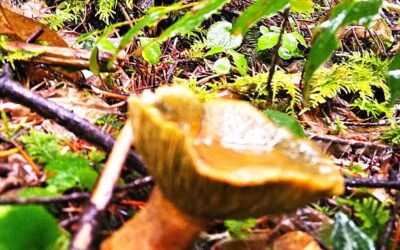
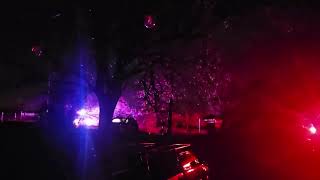


The article I read said James Hartley was found murdered on a small island in Deadman’s lake. Did you see the island?
I looked for the island but didn’t see one. We camped on a high spot on the otherside of a marshy delta which could have been part of the lake which has silted in, so there may have been an island there at one time. Or perhaps the descriptions in the old newspapers were inaccurate or we found the wrong lake (but I don’t think so).